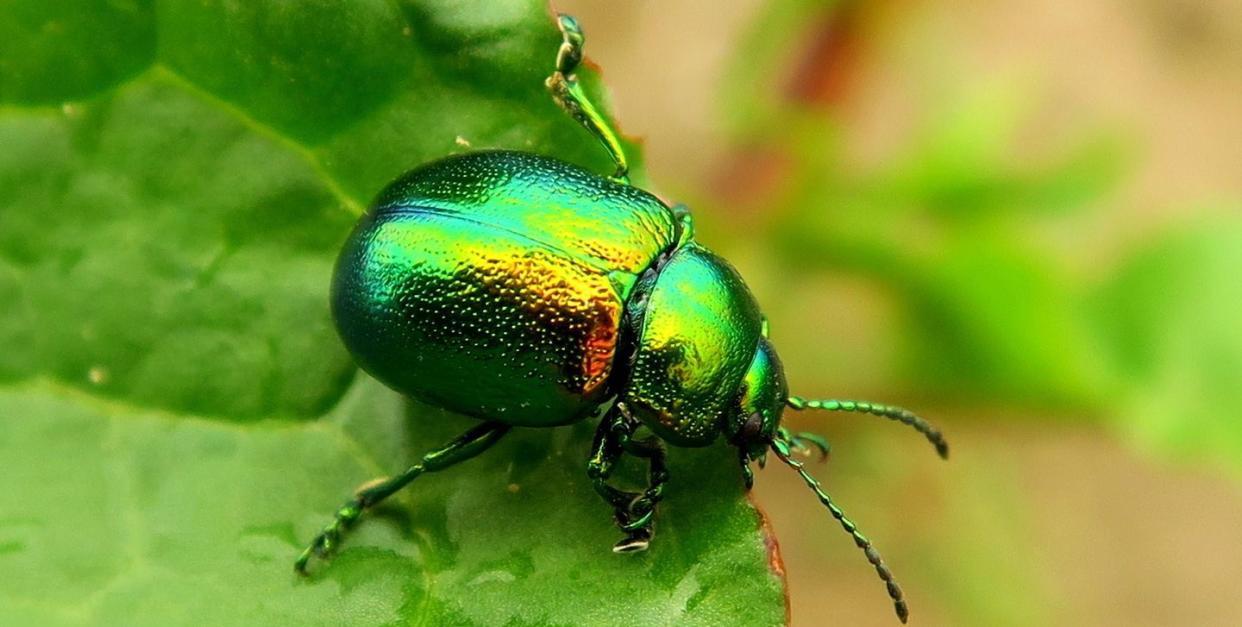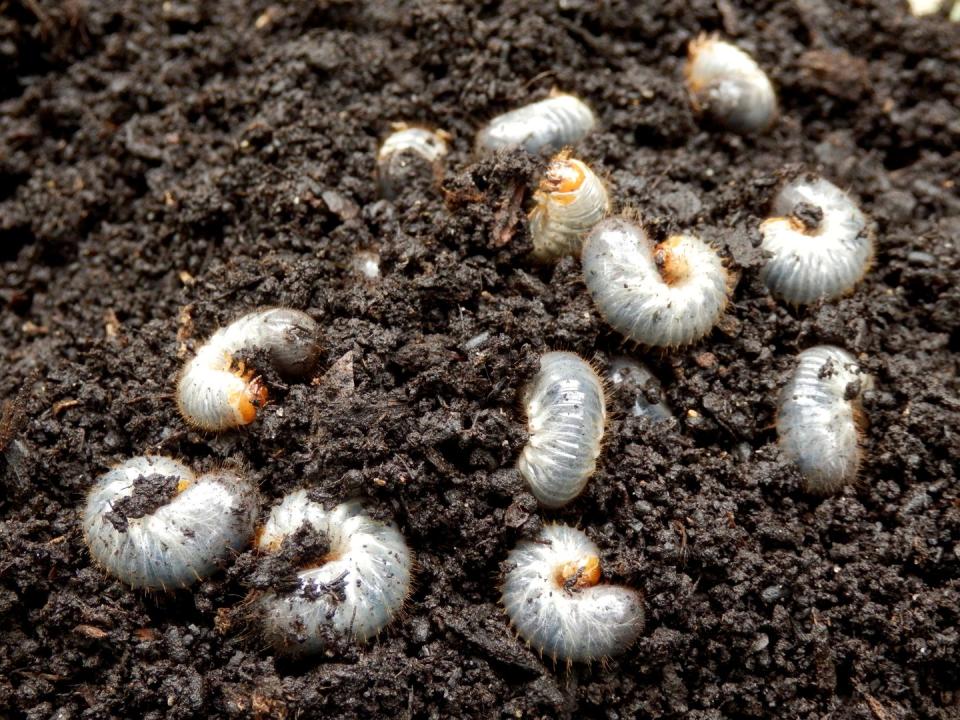Experts Explain How to Get Rid of June Bugs if They’ve Taken Over Your Lawn

Spring and summer make it easy to enjoy blooming gardens and lush lawns—but it’s also the time of year when pests like June bugs thrive. You might have already felt one fly right into you while taking a walk or relaxing on the porch, but they’re more than just a nuisance: They have the potential to wreak havoc on your yard.
The name “June bug” (a.k.a.“June beetle” or “May beetle”—take your pick) doesn’t actually refer to one type of species, says Fred Rozo, a board-certified entomologist for Ehrlich Pest Control. Lots of beetles, from shiny and green to ovular and brown, fall under the umbrella term.
“They can vary in color and commonly appear in the U.S. during warm spring evenings and are attracted to lights,” Rozo says.
The reason why they’re called May beetles and June bugs is “typically due to location in the country and slight differences in temperature,” says Glen Ramsey, a board-certified entomologist and senior technical services manager at Orkin.
Throughout most of their lives, the insects pose a threat to the plant life around your home. But with the right preparation, even the peskiest June bugs won’t be able to do much damage. Here’s what you can do to get rid of them now to prevent them from coming back next year.
What are June bugs, exactly?
“June bug” is a generic name for members of the scarab family of beetles, which contains more than 200 species that live in North America, according to the University of Wisonsin-Madison Horticulture Extension (WHE). Some of the most infamous are Japanese beetles, green June beetles, and European chafers.
A female June bug buries 50 to 200 “small, pearl-like eggs” in the soil, Rozo explains. “After three years of feeding on plant roots, the adults emerge in late summer and bury again for the winter,” he says. In the spring, the adults emerge again to eat foliage. Overall, they live less than a year as an adult, Rozo says.
Not all June bugs are equally harmful to flora—some are mostly benign, while others are much more destructive.

What damage can June bugs cause?
June bugs cause differing damage throughout their lifespans. As grubs, they feed on plant roots, including grass, weeds, vegetable transplants, and ornamental plants, according to Ramsey. “June bugs’ larvae can be the real nuisance in lawns and gardens,” he says. “Also called white grubs, these larvae cut grass at the roots, leaving behind dry, bald patches in lawns.”
They can also attract larger animals like moles and voles that will dig through gardens and yards to hunt them, he says. Small plants and patches of grass will start to wither or die, and larger plants might exhibit symptoms like yellowing or wilting foliage.
Adult beetles have wide-ranging tastes, depending on their location and species. Before long, they also might damage or kill any of these plants (among others), according to Rozo:
Turfgrass
Roses
Corn
Ornamental plants
Thin-skinned fruits, including grapes, peaches, and apples
Evergreen and linden trees
Although their damage to plant life can be severe, neither grubs nor beetles are harmful to people, Rozo says. “However, they can provide a fright if you get hit in the head by a flying insect,” he points out. Just watch out for them around outdoor lights at night—they might fly right into you or any open windows.
What are the signs of a June bug infestation?

June bug grubs live underground, so they’re hard to detect before their damage becomes visible. But Rozo says there are a few things that can be tip-offs you have June bugs:
You have brown patches on your lawn.
Small holes are being dug in your lawn overnight. These holes are often made by skunks or moles searching for grubs, which are a food source for them.
Holes are being chewed in the leaves of some of your plants.
“Monitor your landscape for such signs and follow up upon their detection by confirming the presence of these insects,” Rozo says.
To look for grubs, he recommends digging up some sod in your lawn and inspecting the soil for grayish-white, caterpillar-like bugs that vary from less than an inch to slightly more than an inch long. To look for adults, walk around your property and inspect the leaves of your plants for beetles.
How to get rid of June bugs and grubs
June bugs can be tough to exterminate, especially once they’re established in a certain area. Still, there are a few things you can do to get rid of them:
Put out traps. Commercial beetle traps will lull them in and keep them from crawling out. These can be pretty effective by capturing many at once.
Take them out. If you only notice a handful, you can actually pick them directly off of affected plants and place them in a container of soapy water, which easily kills the insects, per Colorado State University Extension.
Change up your outdoor lights. Try swapping out your white light bulbs for yellow LED bulbs. “All night-time flying insects are drawn to white light,” Rozo explains. “This will eliminate their attraction towards buildings,” and thus, your lawn.
The situation is slightly different with grubs, but there are still things that can help eliminate them:
Watch the water. “Try to avoid over-watering your yard,” Ramsey says, as June bugs are attracted to moisture.
Limit how much fertilizer you use. Fertilizer can lead to some pretty intense root systems happening below ground—and grubs love to feed on those.
Use insecticides. You’ll want to apply a treatment that includes the ingredients carbaryl or trichlorfon, which you can typically find at your local hardware store—and do it in September, Rozo says. “The best time to service the landscaped areas is in September because at that time, the grubs are still close enough to the soil surface to be susceptible to an insecticide,” he says. If you can, it’s also a good idea to apply a treatment in the spring or summer before you have an issue, Ramsey says, “because once the larvae grow, they cause significant damage to plants and grasses.”
If you’re still struggling after those steps, Rozo recommends consulting with your local pest management company, who will be able to assess your situation and give you a customized treatment plan. By targeting the next generation of June bugs, you’ll save your lawn and your other plants, avoiding a headache next summer.
Go here to join Prevention Premium (our best value, all-access plan), subscribe to the magazine, or get digital-only access.
You Might Also Like

